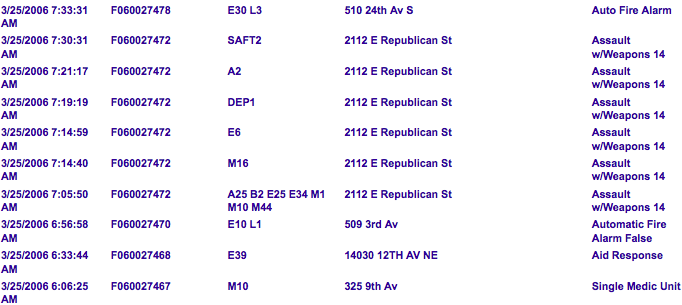Three years ago, early on a Saturday morning, 28-year-old Kyle Huff walked into an East Republican Street home and methodically murdered six people: Jeremy Robert Martin, 26; Melissa Moore, 14; Justin Schwartz, 22; Suzanne Thorne, 15; Jason Travers, 32; and Christopher Williamson, 21.
The 911 log from the morning:
We have also included the report produced for the Seattle Police Department by a panel of experts convened to investigate the incident. The takeaways are tragic and, simultaneously, unsurprising. An unstable and angry person far removed from his support system falls and takes innocent victims with him. Unemployment. Depression. Sex. Guns. Here is the report’s summary:
In the early morning of March 25, 2006, 28-year-old Kyle Huff shot eight young men and women, six of them fatally, at a rave after-party on East Republican Street in the Capitol Hill section of Seattle. The gunman, a transplant from Montana, then committed suicide just as the police arrived on the scene.
Because of the perpetrator’s suicide, there was no need for a detailed investigation
leading to prosecution. Though closed in a legal sense, the bewildering case was not
fully understood. And yet, many members of the Seattle community desired answers to
the many perplexing questions that lingered regarding the gunman’s motives, method
and state of mind.The following pages outline the findings of a special panel charged by the Seattle Police
Department with the task of explaining what appeared inexplicable and unfathomable to
many observers. Over the past three months, James Alan Fox of Northeastern
University, with the support of several other experts in violence and recovery, spent
countless hours reviewing case materials and interviewing survivors, friends and family
of the victims and assailant, and others with information relevant to the episode. The
key findings advanced by the panel are as follows:• The mass shooting reflected planning by the assailant, not a sudden eruption of
rage. His actions were deliberate and methodical, not episodic.
• The shooting was not random. Even though the particular victims wounded or
killed were targets of opportunity, the gunman apparently stalked the rave
community for his attack.
• There was no evidence of a simple explanation for Kyle Huff’s behavior. The
massacre did not appear to be the result of media imitation, drug inhalation or
neurological abnormality (although his self-inflicted head wound eliminated any
opportunity to examine his brain during autopsy).
• In many respects typical of mass murderers, Huff’s actions reflected the longterm
and cumulative effects of frustration and isolation, combined with
externalization of blame or scapegoating.
• Spending day-after-day alone, unemployed, and separated from friends and
family back in Montana, Huff’s depression, fueled by his direction less and
relatively unsuccessful life, was funneled into an obsession with the perceived
dangers associated with the rave community and rave culture.
• Kyle Huff may have been attracted to Seattle’s large and active rave community
as a possible source of friendship and musical entertainment. The rave lifestyle
and belief-system were quite alien to his, however. Not fitting in with a group that
purports to welcome everyone, Huff may have perceived this as rejection,
ultimately blaming the ravers and seeing them in the most negative light.
• Prior to his psychological down-spiral, Huff was considered by those who knew
him in Montana as kind, friendly and happy. Indeed, he was happy when
surrounded by his network of support. Yet his mood and state of mind in Seattle,
where he hardly knew anyone except his twin brother, was clearly different.
• To those who knew Huff well, his murderous behavior was uniformly seen as
uncharacteristic. Without question, there were no clear warning signs that could
have been observed, even by his twin brother. Though there were subtle signs
of emotional trouble, the prospect of violence was beyond consideration.
To add to the words, there are also these sentences believed to be from the shooter himself in a note discovered in a trash bin not far from Huff’s Roosevelt Way apartment.
 Those are the pieces. I’ll leave the rest for you to put together and figure out things like why and when it will happen again.
Those are the pieces. I’ll leave the rest for you to put together and figure out things like why and when it will happen again.





Does anyone know if the two surviving victims of the Huff shootings have recovered?
I recall no news of them at the time or subsequently.
BTW, here’s a thoughtful analysis of the tragedy:
http://brief-treatment.oxfordjournals.org/cgi/content/full/m
I was just thinking of this while taking the bus home last night. I often wonder which house it was; now I know. Thanks for posting this and keeping us aware of what can happen when people are ignored or cast out.
Or when they are invited in. I try not to draw anything but small-degree lessons from what Huff did. There isn’t anything to do to guarantee it won’t happen again. I’m a fatalist of the worst kind. (oh, and this doesn’t mean we shouldn’t do things to make it less likely!)